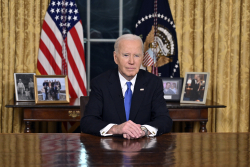Although Tehran has gone to extreme lengths to keep a few of its aging planes airworthy, those planes are simply not very effective in the air.
The recent 12-day war between Israel and Iran—as well as Operation Midnight Hammer, the US Air Force’s bombing campaign against three heavily defended Iranian nuclear sites—demonstrated glaring inadequacies within the Iranian Air Force (IRIAF). Notably, during America’s military operation, more than 100 US aircraft entered the skies over Iran; no Iranian planes attempted to intercept them.
Iran’s air force is impotent for a variety of reasons. Its force structure is in atrophy mode, relying upon Cold War-era aircraft purchased from the West and the Soviet Union that simply cannot keep up with modern air forces. IRIAF doctrine calls for a defensive posture that prioritizes airspace denial, asymmetrical retaliation, and survivability under attack. However, recent events have shown that the abilities of the IRIAF are woefully insufficient to put the doctrine into practice. And with only a few aircraft in the inventory with strike capability, the air force is essentially incapable of engaging in either defensive or offensive operations.
The problem with the IRIAF isn’t merely the outdated nature of the fleet—it’s the fact that it struggles to maintain operational readiness. Said another way, the IRIAF’s reliance on antiquated planes is only its secondary problem; it has an immensely difficult time keeping its aircraft airworthy in the first place. Operational readiness is the Achilles’ heel of the IRIAF.
The two problems are inexorably linked. During the 1979 revolution, Iran inherited then-cutting edge American aircraft—notably the F-14 Tomcat, F-4 Phantom, and F-5 Tiger—from the pro-Western government of the Shah. However, in the years that followed, the United States placed heavy international sanctions on Tehran, making it nearly impossible to procure original parts for those aircraft. As a result, Iran’s only source of spare parts for its original aircraft is other aircraft; the F-14s it still operates are only kept in the air through the cannibalization of parts from other airframes. In other words, only 50 to 60 percent of IRIAF aircraft are flyable; the rest are set aside as a source for spare parts. In some instances, the IRIAF has been able to reverse-engineer spare parts and produce them domestically—but reliability is variable, with the locally made replacements often inferior and less durable than the original.
As one might imagine, the operational readiness of the IRIAF fleet results in low flight hours, and hence pilot inexperience. Iranian fighter pilots reportedly experience as little as 100 flight hours per year on average—significantly lower than NATO or Israeli pilots, who often log more than 250. The crunch on available aircraft has also complicated the training of new pilots; the IRIAF senior pilot corps are mostly holdovers from the Iran-Iraq War in the 1980s.
And although Tehran has gone to extreme lengths to keep a few of its aging planes airworthy, those planes are simply not very effective in the air. Most of them use 1970s- and 1980s-era radar systems, limiting situational awareness and BVR (Beyond Visual Range) capabilities. The IRIAF is completely without Airborne Early Warning and Control (AEW&C) platforms, which hampers airspace control and reaction time. And the IRIAF is deficient with respect to Electronic Warfare capabilities, with virtually no effective airborne jamming or radar spoofing capability—making the IRIAF extremely vulnerable to sophisticated adversaries like Israel or the United States.
To compensate, Iran is forced to rely upon asymmetrical means, like drones and missiles. But with respect to conventional air power, Iran has proven itself to be a paper tiger.
About the Author: Harrison Kass
Harrison Kass is a Senior Defense and National Security Writer at The National Interest. Kass is an attorney and former political candidate who joined the US Air Force as a pilot trainee before being medically discharged. He focuses on military strategy, aerospace, and global security affairs. He holds a JD from the University of Oregon and a master’s in Global Journalism and International Relations from NYU.
Image: Shutterstock / mh.jahanpanah.
















